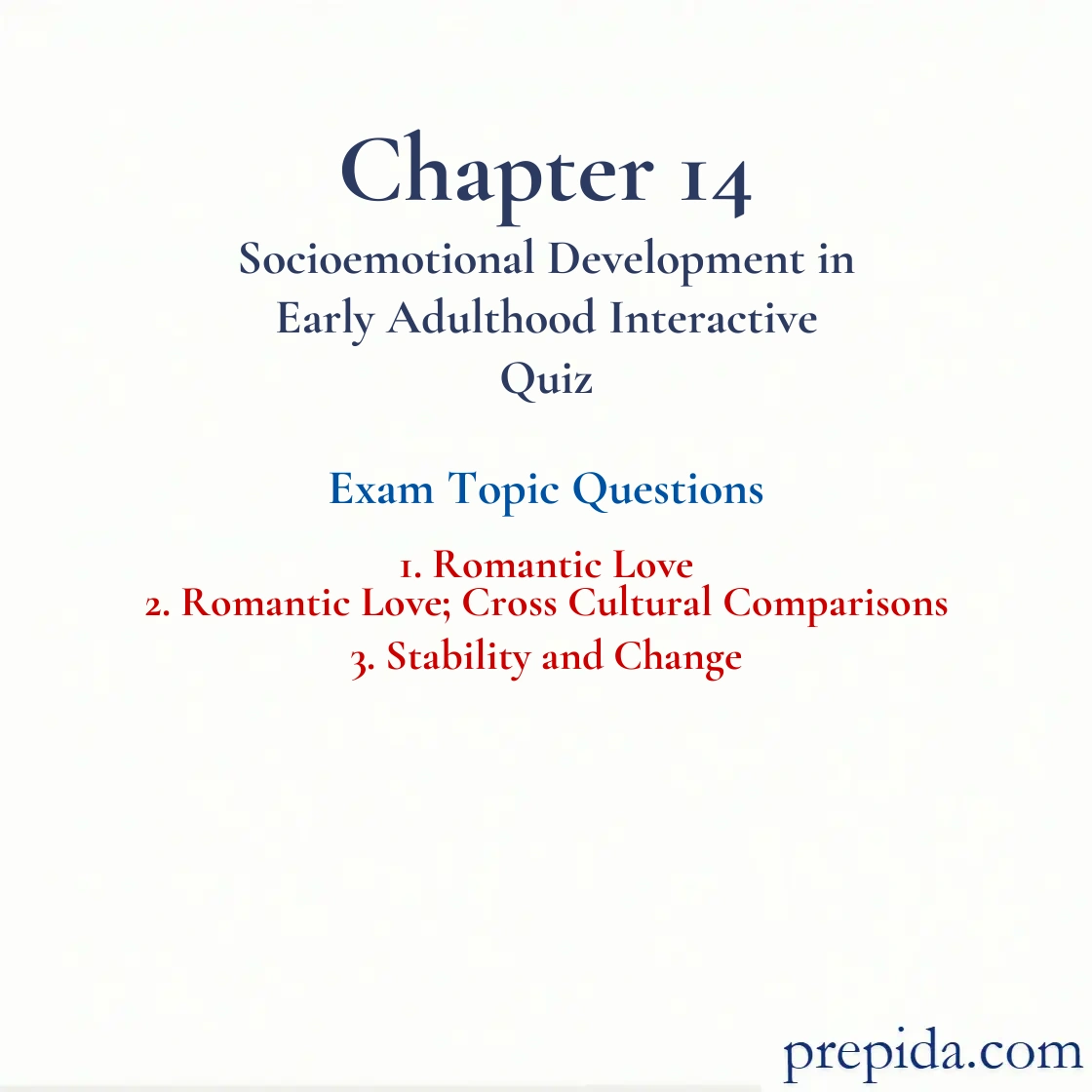
Which of the following is another name for romantic love?
- passionate love
- affectionate love
- companionate love
- consummate love
Affectionate Love: In this type of love, also called companionate love, an individual desires to have the other person near and has a deep, caring affection for the other person.
________ love is also called eros.
- Companionate
- Affectionate
- Romantic
- Consummate
Romantic Love: Also called passionate love or eros, romantic love has strong sexual and infatuation components and often predominates early in a love relationship.
Following a breakup with her boyfriend, Sherry is devastated and cries herself to sleep every night. Eventually, she starts taking control of her life. She accepts the breakup and her feelings and decides to move on. She becomes self-confident and realizes that the breakup has made her stronger. In this scenario, Sherry is most likely experiencing a(n) ________ change following the breakup.
- personal positive
- relational positive
- environmental positive
- organizational positive
Personal Fable: The part of adolescent egocentrism that involves an adolescent’s sense of uniqueness and invincibility (or invulnerability).
Jenny is hurt following a breakup with her boyfriend. However, a few months later, she gets over the breakup and shares her thoughts about the breakup with her best friend and uses such phrases as "We should have communicated better," "I have learned the importance of saying sorry," and "I will not jump into a relationship too quickly." This scenario indicates that Jenny is most likely experiencing a(n) ________ growth following the breakup.
- personal positive
- relational positive
- environmental positive
- organizational positive
Preoperational Stage: Piaget’s second stage, lasting from about 2 to 7 years of age, during which children begin to represent the world with words, images, and drawings, and symbolic thought goes beyond simple connections of sensory information and physical action; stable concepts are formed, mental reasoning emerges, egocentrism is present, and magical beliefs are constructed.
Belinda breaks up with her boyfriend. Although she is extremely upset and heartbroken, she realizes that when she was with her boyfriend, she had completely ignored her friends. She now understands the importance of her friends and apologizes to them. She also realizes that she has more time now and takes up the dance classes that she was always interested in. In this scenario, Belinda is most likely experiencing a(n) ________ change following the breakup.
- personal positive
- relational positive
- environmental positive
- emotional positive
Which of the following statements about romantic love is true?
- Males show lower anxiety about romantic love than females.
- Females show higher avoidance of romantic love than males.
- Males show higher anxiety about romantic love than females.
- Males and females show the same level of avoidance and anxiety about romantic love.
Romantic Love: Also called passionate love or eros, romantic love has strong sexual and infatuation components and often predominates early in a love relationship.
Tiara and Evan, who are classmates, have fallen in love with each other. Tiara feels intense passion for Evan and gets extremely jealous when she sees him talk to other girls in their class. She also has a strong sexual desire for him. In this early part of their relationship, Tiara is most likely experiencing
- companionate love.
- affectionate love.
- consummate love.
- romantic love.
Romantic Love: Also called passionate love or eros, romantic love has strong sexual and infatuation components and often predominates early in a love relationship.
According to Ellen Berscheid, the most important ingredient of romantic love is
- friendship.
- sexual desire.
- long-term commitment.
- spontaneity in behavior.
Tina is in a romantic love relationship with John. She is very intimate with him and does not place emphasis on connections outside of her relationship with him. She also has a very small social network. In the context of cross-cultural variations in romantic relationships, Tina's relationship is most likely characteristic of a(n)
- communist country.
- Marxist country.
- collectivist country.
- individualistic country.
In the context of cross-cultural variations in romantic relationships, in contrast to individualistic countries, individuals in collectivist countries are more likely to
- have a smaller social network.
- have a strong tendency for self-disclosure.
- be less group-oriented.
- have stronger feelings of commitment.
Commitment: Marcia’s term for the part of identity development in which adolescents show a personal investment in identity.
Sara is in an intimate love relationship with Ren. She has a strong commitment toward her relationship with Ren. However, the intimacy in her relationship is diffused as she also places strong emphasis on connections with her family members. According to the cross-cultural variations observed in romantic relationships, Sara's relationship is most likely characteristic of a(n)
- narcissistic country.
- totalitarian country.
- collectivist country.
- individualistic country.
Commitment: Marcia’s term for the part of identity development in which adolescents show a personal investment in identity.
If researchers measure an individual's self-esteem at ages 10, 20, 30, and 40 years, where are they likely to find the most stability?
- when measured at the age of 10 and then again at the age of 30
- when measured at the age of 20 and then again at the age of 30
- when measured at the age of 20 and then again at the age of 40
- when measured at the age of 10 and then again at the age of 40
Self-Esteem: The global evaluative dimension of the self. Self-esteem is also referred to as self-worth or self-image.